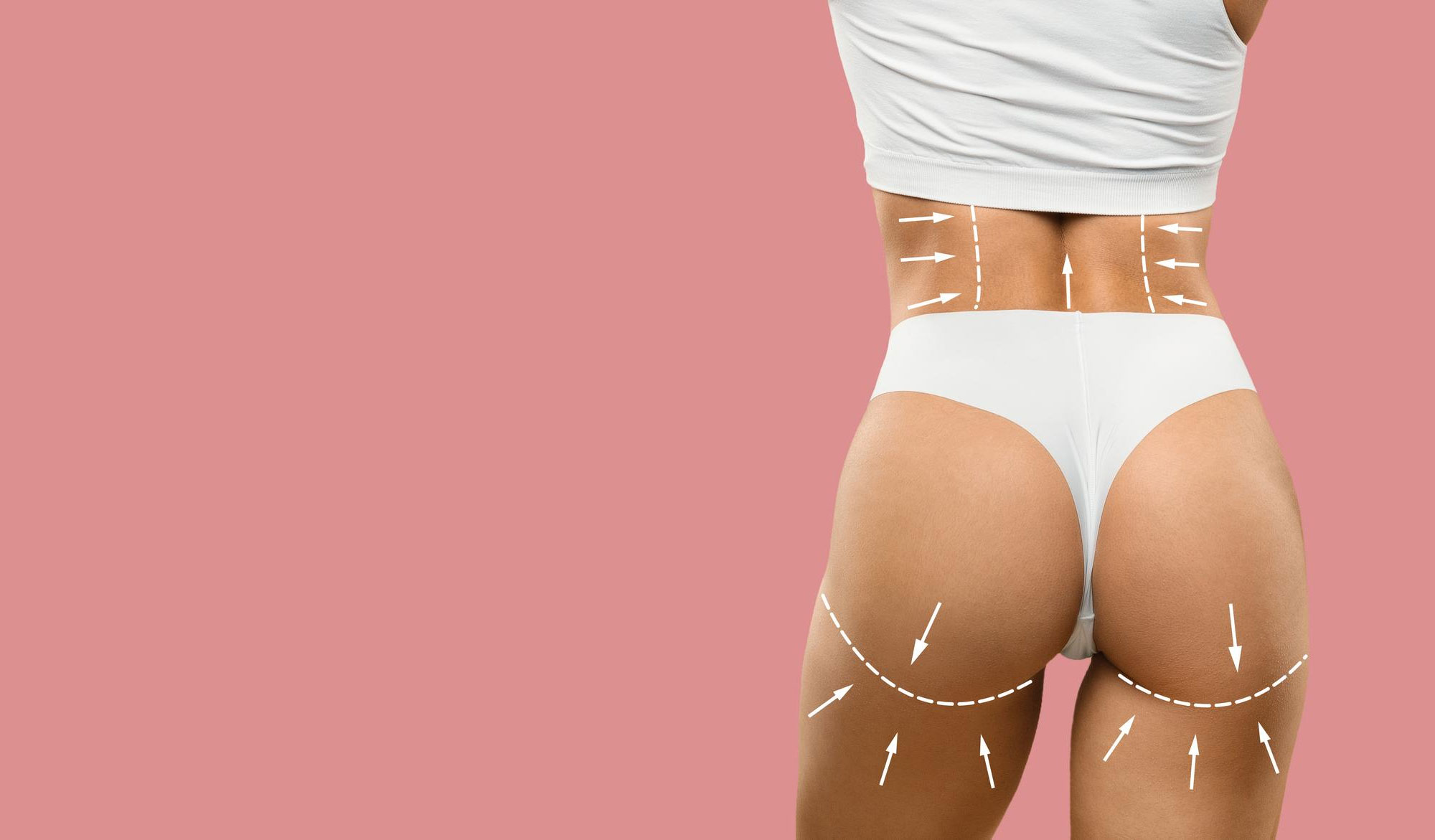What is a thigh lift and why is it preferred?
Thigh lift, medically known as "thighplasty" or "thigh lift", is a surgical procedure to provide a firmer and more aesthetic appearance by removing excess skin and fat tissue accumulated in the upper part of the legs. It is generally aimed to eliminate loosening and sagging in the inner leg (medial thigh) area.
Sometimes people prefer this operation after major weight loss. It is quite common, especially in those who have undergone bariatric surgery or who have lost a large amount of weight by their own efforts, to have loose skin that has ballooned up and down like a balloon. Think of this loose skin as "as if you were wearing pants several sizes too big": Gaps, folds, friction when walking... This can make everyday life difficult and can also significantly affect self-confidence.
In addition, with aging, the elasticity of the skin decreases and especially the inner thigh area becomes prone to sagging. Therefore, this operation can be a solution not only for individuals who have undergone weight loss process but also for those who are disturbed by sagging over time. The aim here is not only to achieve an aesthetic appearance; it is also to reduce irritation between the legs, provide comfort in dressing and increase mobility.
Who is a Suitable Candidate for Thigh Lift Surgery?
Although thigh lift surgery is a part of plastic surgery, it can also be performed in line with medical requirements. So which characteristics make someone a good candidate?
Weight fluctuations and stable weight:
People who have lost a significant amount of weight and have now reached a certain weight balance have more permanent results. If someone whose weight is constantly changing, the results obtained by surgery may also deteriorate if they gain and lose weight again. In a way, you can think of it as "the foundation must be strong when changing the decoration of the house". First of all, it would be healthier to get your body in order, and then turn to fine works, that is, surgeries.
Loss of Skin Elasticity and Sagging Rate:
A sagging and loosened skin structure, especially in the inner leg area, which we can call "skin abundance", can benefit greatly from thigh lift surgery.
General Health Status:
Having chronic conditions such as diabetes, heart disease or circulatory disorders can increase the risks of surgery. Undergoing a comprehensive health assessment before scheduling such surgeries can reduce complications both during and after surgery.
Smoking:
Smoking especially negatively affects blood circulation and tissue healing. Tissue healing is very important in surgeries involving large incisions such as thigh lift. Therefore, it is recommended to quit or at least significantly reduce smoking before and after surgery.
Realistic Expectations:
Thigh lift surgery does not create a miraculous transformation. It does not completely reshape the leg structure; however, it can offer a more pleasing contour and a more comfortable life by removing existing deformations. In other words, your satisfaction rate increases "as long as you set your expectations correctly".
Which Thigh Lift Techniques Can Be Preferred?
There are different techniques of thigh lift surgery. These are determined according to each patient's problem areas, how sagging the skin is and the amount of tissue to be removed. During the operation, fat removal (liposuction) can also be added according to the necessity. The basic techniques we can mention are as follows:
Medial (Inner) Thigh Stretching:
It is the most commonly used method. It is preferred when sagging is intense in the inner leg. Often an incision is made along the groin line and the skin of the leg is stretched upwards, removing excess skin. You can imagine it like "pulling up the overalls": You cut off the excess part and pin the rest up.
Vertical Thigh Lift:
If there is a lot of sagging or excess skin along the length of the leg, a vertical incision extending from the inner leg line to near the knee may be preferred. With this incision, excess skin is removed over a larger area, but it also has the disadvantage that the scar is more prominent.
Mini Thigh Lift:
In some patients, sagging is more limited and collected only in the upper inner leg area. In this case, the sagging skin is removed through a smaller incision in the groin area. The healing process is faster and the scar is smaller.
Outer (Lateral) Thigh Lift:
If there is a significant problem in the outer region, not the inner leg, an incision is made starting from the groin area and extending towards the hip area, and the skin and excess fat tissue are removed. It is often performed as a part of lower body lift surgery.
Spiral Thigh Lift:
A more extensive incision line can be used if there is a laxity near the entire thigh - front, back, inner and outer. This technique can be imagined as "wrapping the thigh 360 degrees". It provides a comprehensive stretching by collecting excess skin from all sides.
Which of these methods to choose is decided by evaluating the amount of sagging in the legs, the person's body mass index, skin structure and wishes. Let's not forget that a surgical technique does not produce the same results in every patient and the patient's anatomical features are the biggest determinant.
How is the surgery planned and which stages does it include?
Preliminary Examination and Planning:
The first step of the surgical process is the examination. Here, the rate of sagging in the legs, skin thickness, area of laxity and general health are assessed. Sometimes it may be necessary to combine with additional procedures such as a tummy tuck or buttock lift to create a holistic lower body contouring plan.
Marking:
Before the operation, the problematic area is identified while standing and the incisions are marked with a pencil. Think of it as "marking the excess fabric in the dress"; where to remove, where to stitch, is planned in detail by the doctor. This part is not to leave a scar after surgery, but on the contrary, it serves to clarify what will be removed from where and how the stitches will be made.
Anesthesia and Making Incisions:
It is usually performed under general anesthesia. So you will be comfortable during the whole operation. In some cases, regional anesthesia (spinal or epidural) and sedation may also be an option. Incision lines are made according to the plan determined by the doctor and excess skin and, if necessary, fatty tissue is also removed.
Tissue Shaping and Stretching:
After the incision is opened, the connective tissue under the skin is shaped accordingly. If liposuction is to be applied, first reducing the fat tissue and then stretching the skin tissue may give a smoother result. Then the excess skin is discarded and the healthy part is pulled up and sutured.
Closure and Drainage Tubes:
At the end of the operation, small tubes called drains are usually placed to prevent excess fluid accumulation. These drains serve for a short time after the operation. After the stitches are removed, a bandage or compression garment (corset) is applied. This garment helps to support the wound area and minimize swelling.
What to Expect and How to Behave During the Recovery Process?
Thigh lift surgery is a medium to large-scale surgery. Therefore, it is important to be careful and patient after surgery.
Pain and Discomfort:
Tenderness and pain in your legs is normal in the first days. Although it can be controlled with painkillers and is at a tolerable level, it is necessary to be careful in daily movements. It is imperative to avoid moving too fast or activities that put excessive strain on the legs. During this period, it is useful to think like "not to rip the seams of a newly sewn trousers while straining".
Rest and Movement:
After surgery, you usually need a few days of rest in the hospital or at home. But instead of lying down completely, improving your circulation with short walks reduces the risk of blood clots. As with everything, "balance" is important: Neither lie down all the time nor move excessively and strain the seams.
Corset Use and Care:
Regular use of the corset recommended by your doctor both accelerates the healing process and helps to shape. If you have drains, they will be removed in a few days. During this period, regular dressings and attention to wound hygiene reduce the risk of infection.
Return to Daily Life:
After surgery, your return to work and social activities may vary depending on the physical condition of the work you need to do. Light-paced work such as office work is usually possible after 2-3 weeks, while for those who work in heavy jobs or plan to exercise intensively, this period may take up to 4-6 weeks.
Long Term Recovery:
It can sometimes take several months for the swelling to go down completely and the final result to be visible. It can also take 6 months to 1 year for the surgical scars to fade and become less prominent. It is important to be patient during this process and to go to your doctor's controls regularly.
What are the Possible Risks and Complications of this Surgery?
As with any surgical intervention, there are some risks in thigh lift surgery. Although it is not possible to completely eliminate the risks, choosing a physician and paying attention to the preoperative preparation process can reduce the complication rate.
Infection
It is an operation with wide suture lines. Hygiene, regular dressings and using antibiotics recommended by the physician help to minimize the risk of infection.
Bleeding and Hematoma:
Bleeding may occur during or after surgery. Although this is usually kept under control with drains, sometimes additional intervention may be needed.
Separation of Sutures (Dehiscence):
The skin in the surgical area is in an area of constant movement and tension. If too much stress is placed on the stitches, the wound edges may open. To prevent this situation, it is essential to act carefully in the first weeks.
Seroma (Fluid Accumulation):
Fluid may accumulate in some parts after surgery. Drains reduce this risk; however, if seroma still develops, the fluid can be drained with the help of a needle.
Nerve Damage and Numbness:
Temporary or permanent numbness may be seen in the area due to cutting of the skin nerves. Most of the time it improves over time.
Scar formation:
Since the suture line covers a large area, it is not possible for the scars to disappear completely. However, scars usually remain on the groin line and inner leg. As time passes, the color of the scars may fade depending on the suture technique used and the skin structure.
Having the surgery performed by an experienced plastic surgeon and following surgical planning and sterilization rules can greatly reduce the risks. Nevertheless, it is necessary to know the inherent risks of this surgery and decide accordingly.
What are the Benefits of Thigh Lift Surgery?
When we talk about the risks, the question may arise, "So what are the advantages that are worth all this trouble?" Thigh lift surgery offers a number of benefits both aesthetically and functionally, especially by removing sagging and excess skin:
A More Shapely Silhouette:
The smoother and more proportionate appearance of the lines extending from the hips to the knee greatly increases the self-confidence of most people. Especially when wearing tights, shorts and tight clothes, the discomfort felt can be greatly reduced.
Comfortable Movement:
Flabby skin, especially on the inner legs, can cause friction and even skin irritation when walking. Removing excess skin increases freedom of movement, making it easier to play sports, take long walks or climb up and down stairs.
Facilitating Personal Hygiene:
Accumulation of sweat and moisture in the sagging areas can lead to both bad odors and fungal or bacterial growth. After surgery, hygiene becomes simpler and more comfortable as friction and accumulation points are reduced.
Psychological Well-being:
Seeing oneself in the mirror more compact and toned can create a feeling of being at peace with one's physical appearance. This can lead to a more positive outlook on daily life, feeling more comfortable in social situations and overall happiness.
Freedom of Clothing Choice:
Many people who do not want to wear some clothes because of sagging or who say "I do not wear skirts because I cannot make peace with my legs" act more freely in their wardrobe after surgery. The courage to wear what suits you is one of the factors that nourish self-confidence.
What should be considered in the long term and how can the results be maintained?
Although it is possible to achieve the desired aesthetic appearance with surgery, it is very important to maintain the weight balance so that "the intervened area does not deteriorate again". Gaining and losing excessive weight again may cause the skin to sag again. Regular exercise, especially strengthening the leg muscles, supports the postoperative shape. A protein-based diet can contribute to tissue repair. Drinking plenty of water helps the skin retain moisture and maintain its elasticity. Scars may remain in the area after surgery. In order to reduce the appearance of these scars, it may be useful to use the creams and ointments recommended by your doctor regularly and not to neglect massage techniques. Using protective creams against the harmful effects of the sun also prevents premature wear of the skin. Going to the doctor at regular intervals after the surgery provides early detection of minor problems that may arise in the long term. If necessary, it may be possible to correct even a small deformation. Aging cannot be stopped. Your skin may still loosen a little over time, but if you have had extensive sagging before, the surgery creates a much better base. Small loosening is probably much less noticeable than it was at first.



















